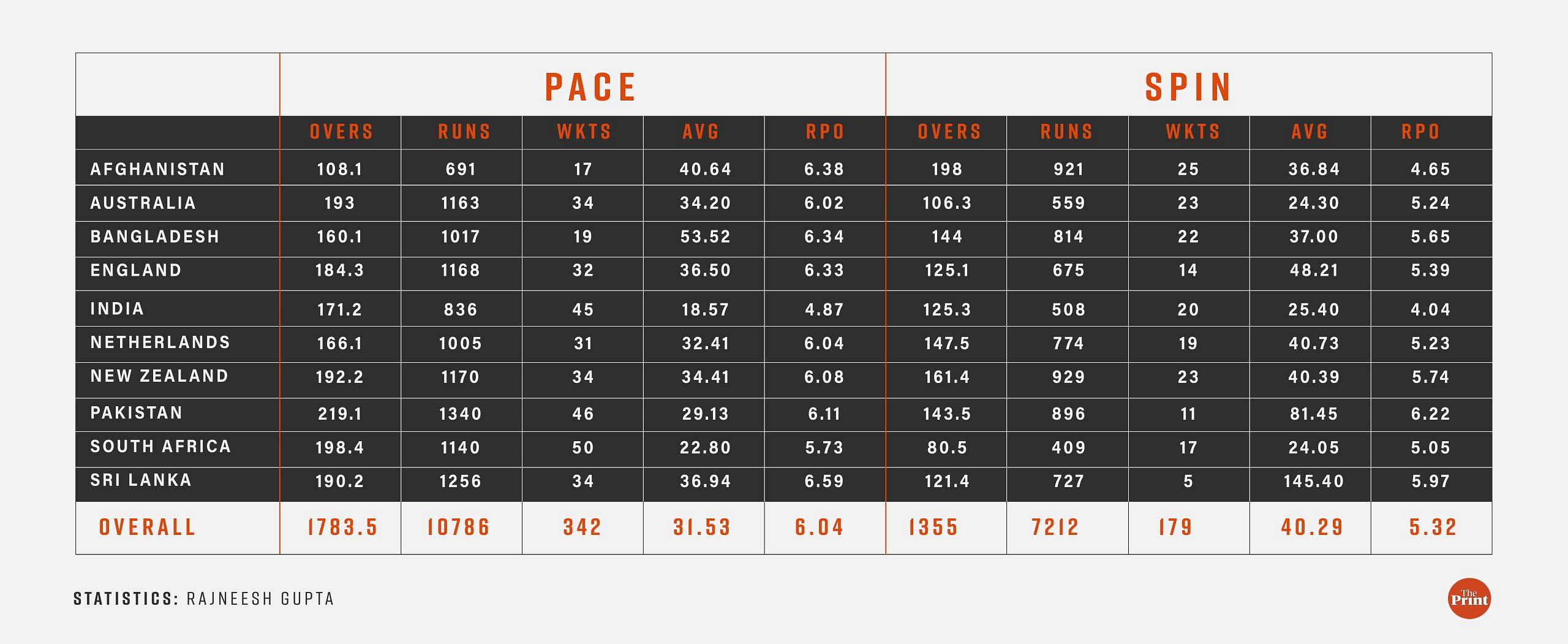One of the major ‘upsets’ in the ongoing ICC Men’s Cricket World Cup came early in the tournament. The Netherlands’ team, built on the backs of some South Asian-origin cricketers, ran through the South African batting line-up to startle most cricket fans and analysts, successfully defending a modest total of 245. While the Dutch captain was richly rewarded ‘player of the match’ for his gritty, defining knock of 78, what went largely unnoticed was how the victory was scripted by four early wickets in the first 12 overs—three of those by spinners Colin Ackerman and Roelof van der Merwe.
Much before the Netherlands’ slow burn, India spun a similar web of magic in their first encounter of the tournament, restricting the Australians to 199 to set the tone that we would see in future matches. Whether it’s the Afghan trio of Mujeeb Ur Rahman, Mohammad Nabi, and Rashid Khan walking all over the English batters, or Australia’s Adam Zampa, New Zealand’s Mitchell Santner, and South Africa’s Tabraiz Shamsi, spinners have turned up in the 2023 World Cup defying low expectations with most eyes trained on speedsters. This fight back from spinners may not be immediately discernible if you look only at the ‘wickets taken’ column; their defining, match-shifting roles emerge in the way they have trapped batters and choked runs in the middle overs in a tournament where a 350+ score has become a regular affair.
Consider this: pacers have dismissed more top-order batters (242) than spinners (124) by our cut-off date of 3 November. However, spinners were slightly ahead in terms of percentage of dismissed batters from No.7 to No.11 (30.73) than pacers (29.24). And pacers have accounted for more lower order batters (100) than their counterparts (55).


Spinners sparkle
Adam Zampa bravely overcame his wicket-less outing against India in by taking three four-wicket hauls — against Sri Lanka, Pakistan, and the Netherlands. Kiwi left-armer Santner returned his five-wicket haul against the Netherlands.
Spinners have won the battles almost single-handedly a few times. Bangladesh, a spin-heavy team, strangled Afghanistan, with their captain and left-armer Shakib Al Hasan (3/30) and offie Mehedi Hasan (3/25) ensuring a six-wicket win in the small outfield in Dharamsala.
The incisive Indian spin trio dismissed six of the top seven batters to completely annihilate Australia in Chennai and register a six-wicket win. After speedster Bumrah gave a flying start, Ravindra Jadeja (3/28), left-arm wrist spinner Kuldeep Yadav (2/42), and brainy Ravichandran Ashwin (1/34) choked the Aussies, ensuring none could reach the 50-run mark. All three spinners bowled their full quota of 10 overs.
Another spinners’ show came when Santner (5/59) and Rachin Ravindra (1/46) joined hands to give New Zealand a 99-run win over the Netherlands in Hyderabad.
The biggest upset caused by the slow men, however, was Afghanistan defeating the defending champions, England, and that too at a small ground in Delhi. England had no answers to experienced leg-spinner Rashid Khan (3/37) and offie Mohammed Nabi (2/16) as Afghanistan won by 69 runs. In Afghanistan’s other huge upset win, an eight-wicket verdict against Pakistan in Chennai, Noor Ahmed Lakanwal, the prodigious left-arm wrist spinner, shone with a three-wicket burst.
So far, there have been 16 four-wicket hauls and the spinners have bagged six of them.
Different parameters, different numbers
It is generally expected that spinners would dominate on Indian pitches. And yet, in this World Cup, teams such as India, Pakistan, and Australia have led with their pace bowlers.
Afghanistan is the only team that has mostly trusted its spinners. Four of its bowlers have snared 25 wickets in 198 overs, more than their pacers (17 wickets in 108.1 overs) in seven matches.
The pitch factor
Unlike in Test matches, pitches for ODIs and T20 Internationals are prepared with batters in mind to enable them to pile up runs. The pitches prepared for the World Cup so far have been top class, and have something for all.
“These are one-dayers, so you won’t get turning pitches in the World Cup. These matches are different from bilateral matches, i.e. mostly Tests, for which pitches are made to order – an important aspect vis-à-vis pitches made for a World Cup,” former India left-arm spinner Maninder Singh told The Print.
Legendary leg-spinner BS Chandrasekhar acknowledges the change. “The general standard of pitches has improved very much from our time; they have changed enormously. That’s why sometimes fast bowlers take more wickets, at other times spinners get more,” Chandrasekhar told The Print. “Also, bats are very strong now, and when hit the ball often goes out of the ground. Just see how many sixes were hit in our time and how many are hit now.”
A lot of credit for the change in pitches’ character goes to former head of the pitches committee Daljit Singh. In 2012, the Board of Control for Cricket in India (BCCI) launched a curators’ course under his supervision. “I told the BCCI to post curators at all important centres. I received their full support. Today, there are about 90 qualified coaches in the country. It will be even better if retired cricketers, too, take up curatorship,” Singh, a former wicket-keeper from Bihar who once held the Ranji Trophy record for most dismissals, told The Print.
In 1996-97, the BCCI paid NZ$32,400 to the New Zealand Sports Turf Institute for organising a curatorship programme in India. Today, the country is self-reliant in making pitches implementing modern methods.
And yet, spinners in this World Cup have marked their turf, showing teams why a Zampa or a Rashid, a Kuldeep or a Nabi can’t be done without. Modern-day cricket spectators adoring and falling head over heels for speed will always have to make room in their hearts for a slow, spinning arm.
The author has covered cricket for over three decades, based in New Delhi. He tweets at @AlwaysCricket.
(Edited by Prashant)



